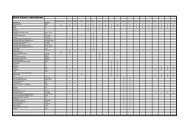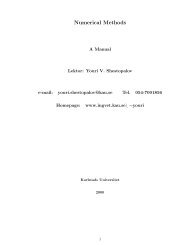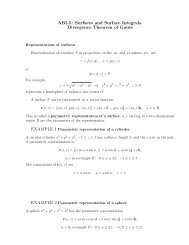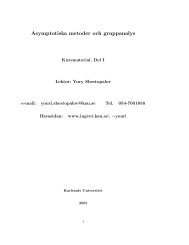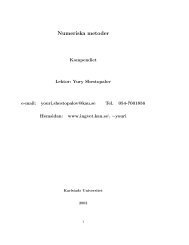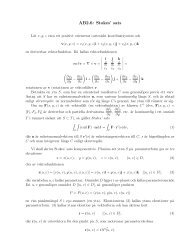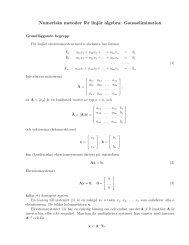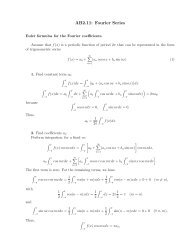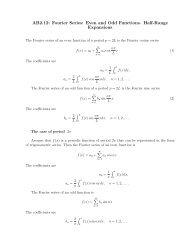Theorem 28 Let λ 1 , λ 2 , . . . , and φ 1 , φ 2 , . . . , be eigenvalues and eigenfunctions (eigenvectors)of an integral operator with a symmetric kernel and let h(x) ∈ L 2 [a, b], i.e.,∫ ba|h(x)| 2 dx ≤ ∞.If K(x, y) is a Hilbert–Schmidt kernel, i.e., a square-integrable function in the square Π ={(x, y) : a ≤ x ≤ b, a ≤ y ≤ b}, so thatthen the function∫ b ∫ baaf(x) = Ah =|K(x, y)| 2 dxdy < ∞, (222)∫ baK(x, y)h(y)dy (223)is decomposed into an absolutely and uniformly convergent Fourier series in the orthonornalsystem φ 1 , φ 2 , . . . ,∞∑f(x) = f n φ n (x), f n = (f, φ n ).n=1The Fourier coefficients f n of the function f(x) are coupled with the Fourier coefficients h n ofthe function h(x) by the relationshipsso thatf(x) =∞∑n=1Setting h(x) = K(x, y) in (224), we obtainK 2 (x, y) =f n = h nλ n, h n = (h, φ n ),h nλ nφ n (x) (f n = (f, φ n ), h n = (h, φ n )). (224)∞∑n=1ω n (y)λ nφ n (x), ω n (y) = (K(x, y), φ n (x)), (225)and ω n (y) are the Fourier coefficients of the kernel K(x, y). Let us calculate ω n (y). We have,using the formula for the Fourier coefficients,ω n (y) =or, because the kernel is symmetric,ω n (y) =Note that φ n (y) satisfies the equation∫ ba∫ baK(x, y)φ n (x)dx, (226)K(x, y)φ n (x)dx, (227)∫ bφ n (x) = λ n K(x, y)φ n (y)dy. (228)a44
Replacing x by y abd vice versa, we obtainso thatNow we haveIn the same manner, we obtainand, generally,∫1bφ n (y) = K(y, x)φ n (x)dx, (229)λ n aω n (y) = 1 λ nφ n (y).K 2 (x, y) =K 3 (x, y) =K m (x, y) =which is bilinear series for kernel K m (x, y).For kernel K(x, y), the bilinear series isK(x, y) =∞∑n=1∞∑n=1∞∑n=1∞∑n=1φ n (x)φ n (y). (230)λ 2 nφ n (x)φ n (y),λ 3 nφ n (x)φ n (y). (231)λ m nφ n (x)φ n (y)λ n. (232)This series may diverge in the sense of C-norm (i.e., uniformly); however it alwyas convergesin L 2 -norm.11.2 Hilbert–Schmidt theorem for integral operatorsConsider a Hilbert–Schmidt integral operator A with a symmetric kernel K(x, y). In this case,the following conditions are assumed to be satisfied:i Aφ(x) =iiiii∫ b ∫ baa∫ baK(x, y)φ(y)dy,|K(x, y)| 2 dxdy ≤ ∞, (233)K(x, y) = K(y, x).According to Theorem 18, A is a completely continuous selfadjoint operator in the space L 2 [a, b]and we can apply the Hilbert–Schmidt theorem 24 to prove the following statement.45
- Page 1 and 2: Karlstad UniversityDivision for Eng
- Page 3 and 4: 10.5 The Hilbert-Schmidt theorem .
- Page 5 and 6: 2 Notion and examples of integral e
- Page 7 and 8: Subtracting termwise we obtain an o
- Page 9 and 10: with the initial conditiony(x 0 ) =
- Page 11 and 12: Example 7 The space C[a, b] of cont
- Page 13 and 14: where the kernel K(x, y) is a conti
- Page 15 and 16: and so on, obtaining for the (n + 1
- Page 17 and 18: Thus the common term of the series
- Page 19 and 20: Proof. To prove the theorem, it is
- Page 21 and 22: Theorem 9 (Superposition principle)
- Page 23 and 24: A, being completely continuous in t
- Page 25 and 26: These conditions are equivalent to
- Page 27 and 28: In particular, if λ is a regular v
- Page 29 and 30: so thatanda 11 =a 12 =a 21 =a 22 =f
- Page 31 and 32: Therefore the solution isφ(x) = f(
- Page 33 and 34: ∫ bc n = . . .a∫ ba∣K(y 1 , y
- Page 35 and 36: is called the Euclidian space.In a
- Page 37 and 38: Now note that K N (x, y) in (189) i
- Page 39 and 40: Proof. Assume that y n ∈ Im T and
- Page 41 and 42: We see that, on the one hand, vecto
- Page 43: Multiply equality (213) by ¯φ 0 a
- Page 47 and 48: 12 Harmonic functions and Green’s
- Page 49 and 50: Since on Ω(x, r) we havegrad y Φ(
- Page 51 and 52: From Green’s first formula applie
- Page 53 and 54: which proves the continuity of the
- Page 55 and 56: where B 1 is a constant taken accor
- Page 57 and 58: Theorem 36 The operators I − K 0
- Page 59 and 60: Theorem 41 Let D ∈ R 2 be a domai
- Page 61 and 62: n = 2 π∫1−1f(x)U n (x) √ 1
- Page 63 and 64: A similar statement is valid for th
- Page 65 and 66: In some cases one can determine the
- Page 67 and 68: Coefficient a 0 vanishes because (s
- Page 69 and 70: Expand the right-hand side in the C
- Page 71 and 72: We see that the equation has the un
- Page 73 and 74: or, in other notation,andorL = {l n
- Page 75 and 76: where T n (x) = cos(n arccos x) are
- Page 77 and 78: and the integral equationwhereΦ N
- Page 79 and 80: Let us expand the functiong(s) = 1l
- Page 81 and 82: Assume that X n and Y n are the spa



